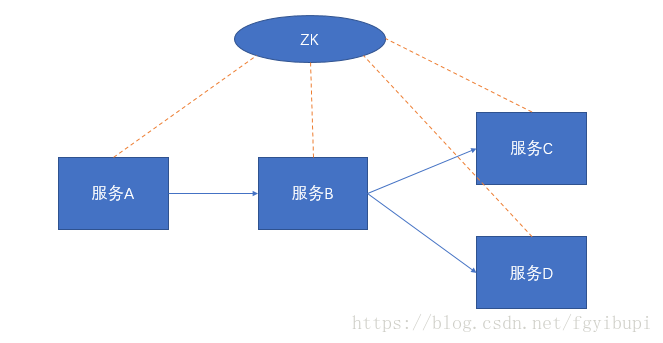这里我们使用的是Apache dubbo官方提供的starter[0.1.0版本]。其使用的dubbo版本是2.5.10。我们将通过源码分析一下dubbo 的优雅停机是如何实现的。
引入Apache dubbo starter
<!-- 注意这里要引入zkclient,否则会找不到zkclient jar包 -->
<dependency>
<groupId>com.github.sgroschupf</groupId>
<artifactId>zkclient</artifactId>
<version>0.1</version>
</dependency>
<dependency>
<groupId>com.alibaba.boot</groupId>
<artifactId>dubbo-spring-boot-starter</artifactId>
<version>0.1.0</version>
</dependency>
备注:官方地址:Apache dubbo

官方优雅停机解释
Dubbo 是通过 JDK 的 ShutdownHook 来完成优雅停机的,所以如果用户使用 kill -9 PID 等强制关闭指令,是不会执行优雅停机的,只有通过 kill PID 时,才会执行。具体请参考官方文档: 优雅停机
源码分析
注册shutdownhook
dubbo在com.alibaba.dubbo.config.AbstractConfig中通过静态初始化块注册shutdownhook
static {
Runtime.getRuntime().addShutdownHook(new Thread(new Runnable() {
public void run() {
if (logger.isInfoEnabled()) {
logger.info("Run shutdown hook now.");
}
ProtocolConfig.destroyAll();
}
}, "DubboShutdownHook"));
}
我们进入到ProtocolConfig.destroyAll():
public static void destroyAll() {
if (!destroyed.compareAndSet(false, true)) {
return;
}
//1. 关闭注册中心
//具体实现见zkClient.close():com.alibaba.dubbo.registry.zookeeper.ZookeeperRegistry#destroy
AbstractRegistryFactory.destroyAll();
//2。 Wait for registry notification
//这一句是新版dubbo的关键改动之处。老版本没有这几行sleep的代码【请读者自行阅读老版本的源码】。默认10秒,可以通过 [dubbo.service.shutdown.wait] 配置
//
try {
Thread.sleep(ConfigUtils.getServerShutdownTimeout());
} catch (InterruptedException e) {
logger.warn("Interrupted unexpectedly when waiting for registry notification during shutdown process!");
}
//3. 销毁所有的protocol
ExtensionLoader<Protocol> loader = ExtensionLoader.getExtensionLoader(Protocol.class);
for (String protocolName : loader.getLoadedExtensions()) {
try {
Protocol protocol = loader.getLoadedExtension(protocolName);
if (protocol != null) {
protocol.destroy();
}
} catch (Throwable t) {
logger.warn(t.getMessage(), t);
}
}
}
上面第一步通过AbstractRegistryFactory.destroyAll()来“注销”在所有注册中心注册的服务,通过调用ZkClient客户端的zkClient.close()关闭ZK长连接。这样服务消费者就看不到已经被注销的服务了。当然这是理想情况。毕竟从服务提供者注销自己,到消费者发现提供者不可用中间存在一定的时间差。
第二步是等待一定时间。原因后面会讲。
步骤三是关闭自己暴露的服务和自己对下游服务的调用。假设我们使用的是dubbo协议,protocol.destroy()其实会调用com.alibaba.dubbo.rpc.protocol.dubbo.DubboProtocol#destroy方法:
public void destroy() {
for (String key : new ArrayList<String>(serverMap.keySet())) {
ExchangeServer server = serverMap.remove(key);
if (server != null) {
try {
if (logger.isInfoEnabled()) {
logger.info("Close dubbo server: " + server.getLocalAddress());
}
//优雅的关闭提供的服务
server.close(ConfigUtils.getServerShutdownTimeout());
} catch (Throwable t) {
logger.warn(t.getMessage(), t);
}
}
}
for (String key : new ArrayList<String>(referenceClientMap.keySet())) {
ExchangeClient client = referenceClientMap.remove(key);
if (client != null) {
try {
if (logger.isInfoEnabled()) {
logger.info("Close dubbo connect: " + client.getLocalAddress() + "-->" + client.getRemoteAddress());
}
//优雅的关闭对下游服务的调用
client.close(ConfigUtils.getServerShutdownTimeout());
} catch (Throwable t) {
logger.warn(t.getMessage(), t);
}
}
}
//关闭幽灵链接
for (String key : new ArrayList<String>(ghostClientMap.keySet())) {
ExchangeClient client = ghostClientMap.remove(key);
if (client != null) {
try {
if (logger.isInfoEnabled()) {
logger.info("Close dubbo connect: " + client.getLocalAddress() + "-->" + client.getRemoteAddress());
}
client.close(ConfigUtils.getServerShutdownTimeout());
} catch (Throwable t) {
logger.warn(t.getMessage(), t);
}
}
}
stubServiceMethodsMap.clear();
super.destroy();
}
上面方法中优先关闭自身对外提供的服务,然后关闭外部的引用,最后关闭幽灵链接(ghostClient)。很容易理解,如果先关闭外部的引用链接,而自身的链接没有关闭,那么就会出现链接不可用而报错的情况。
关闭自身dubbo服务,分析一下com.alibaba.dubbo.remoting.exchange.support.header.HeaderExchangeServer#close(int)的代码:
public void close(final int timeout) {
startClose();//标记进入关闭流程
if (timeout > 0) {
final long max = (long) timeout;
final long start = System.currentTimeMillis();
//将channel标记为只读。广播 READONLY 事件给所有 Consumer 们,告诉它们不要在调用我了!!!目的是如果此处注册中心挂掉的情况,依然能达到告诉 Consumer ,我要下线了的功能。
if (getUrl().getParameter(Constants.CHANNEL_SEND_READONLYEVENT_KEY, true)) {
sendChannelReadOnlyEvent();
}
//等待所有正在进行中的调用都执行完成,或者达到了超时时间
while (HeaderExchangeServer.this.isRunning()
&& System.currentTimeMillis() - start < max) {
try {
Thread.sleep(10);
} catch (InterruptedException e) {
logger.warn(e.getMessage(), e);
}
}
}
doClose();//关闭心跳检测等
server.close(timeout);//关闭真正的netty的通信通道,如果你是用的netty的话
}
那么dubbo是如何判断是否还有调用执行中的任何呢?这就要去看com.alibaba.dubbo.remoting.exchange.support.DefaultFuture#CHANNELS中是如何实现的了。当发起一个请求时,会在CHANNELS中记录当前请求的id和channel的键值对;当有获得返回或者取消请求的时候,将该键值对从CHANNELS中删除。所以只要CHANNELS不为空,则表明有请求还未执行完毕。接下来看doClose方法:
private void doClose() {
//线程安全的标记已关闭状态
if (!closed.compareAndSet(false, true)) {
return;
}
//停止心跳检测
stopHeartbeatTimer();
try {
//停止心跳检测的定时任务
scheduled.shutdown();
} catch (Throwable t) {
logger.warn(t.getMessage(), t);
}
}
上面的代码主要是标记closed=true,并且关闭了心跳检测,这样一来,就不会处理新的请求了,注册中心也检测不到该服务。而server.close(timeout)则主要是关闭netty的通信通道channel,可以参看AbstractServer#close和NettyServer#doClose方法。
现在看一下当前服务作为客户端时,referenceClient的关闭过程 :com.alibaba.dubbo.rpc.protocol.dubbo.ReferenceCountExchangeClient#close(int):
public void close(int timeout) {
if (refenceCount.decrementAndGet() <= 0) {
if (timeout == 0) {
client.close();
} else {
client.close(timeout);
}
client = replaceWithLazyClient();
}
}
这里timeout是服务器停止的等待时间,用于优雅停机。进入
com.alibaba.dubbo.remoting.exchange.support.header.HeaderExchangeClient#close(int):
public void close(int timeout) {
// 标记client进入关闭流程.具体代码见com.alibaba.dubbo.remoting.transport.AbstractPeer#startClose
startClose();
doClose();//停止心跳检测。具体实现见com.alibaba.dubbo.remoting.exchange.support.header.HeaderExchangeClient#stopHeartbeatTimer
channel.close(timeout);
}
跟进channel.close方法com.alibaba.dubbo.remoting.exchange.support.header.HeaderExchangeChannel#close(int):
//优雅关闭channel。这里会一直等待channel的关闭,直到超时强制关闭
public void close(int timeout) {
if (closed) {
return;
}
closed = true;
if (timeout > 0) {
long start = System.currentTimeMillis();
while (DefaultFuture.hasFuture(channel)
&& System.currentTimeMillis() - start < timeout) {
try {
Thread.sleep(10);
} catch (InterruptedException e) {
logger.warn(e.getMessage(), e);
}
}
}
close();
}
那么什么是幽灵链接(ghostClient)呢?在获取链接的时候,如果链接为空或者已经被关闭了,那么就会创建ghostClientcom.alibaba.dubbo.rpc.protocol.dubbo.DubboProtocol#getSharedClient:
/**
* Get shared connection
*/
private ExchangeClient getSharedClient(URL url) {
String key = url.getAddress();
ReferenceCountExchangeClient client = referenceClientMap.get(key);
if (client != null) {
if (!client.isClosed()) {
client.incrementAndGetCount();
return client;
} else {
referenceClientMap.remove(key);
}
}
synchronized (key.intern()) {
ExchangeClient exchangeClient = initClient(url);
client = new ReferenceCountExchangeClient(exchangeClient, ghostClientMap);
referenceClientMap.put(key, client);
ghostClientMap.remove(key);
return client;
}
}
我们进入ReferenceCountExchangeClient:
public ReferenceCountExchangeClient(ExchangeClient client, ConcurrentMap<String, LazyConnectExchangeClient> ghostClientMap) {
this.client = client;
refenceCount.incrementAndGet();
this.url = client.getUrl();
if (ghostClientMap == null) {
throw new IllegalStateException("ghostClientMap can not be null, url: " + url);
}
this.ghostClientMap = ghostClientMap;
}
去查找类ReferenceCountExchangeClient中ghostClientMap的赋值代码:
//幽灵client,
private LazyConnectExchangeClient replaceWithLazyClient() {
//这个操作只为了防止程序bug错误关闭client做的防御措施,初始client必须为false状态
URL lazyUrl = url.addParameter(Constants.LAZY_CONNECT_INITIAL_STATE_KEY, Boolean.FALSE)
.addParameter(Constants.RECONNECT_KEY, Boolean.FALSE)
.addParameter(Constants.SEND_RECONNECT_KEY, Boolean.TRUE.toString())
.addParameter("warning", Boolean.TRUE.toString())
.addParameter(LazyConnectExchangeClient.REQUEST_WITH_WARNING_KEY, true)
.addParameter("_client_memo", "referencecounthandler.replacewithlazyclient");
String key = url.getAddress();
//最差情况下只有一个幽灵连接
LazyConnectExchangeClient gclient = ghostClientMap.get(key);
if (gclient == null || gclient.isClosed()) {
gclient = new LazyConnectExchangeClient(lazyUrl, client.getExchangeHandler());
ghostClientMap.put(key, gclient);
}
return gclient;
}
现在来说一下2.5.10版本最新的改动,用于实现更良好的优雅停机,也就是上面最开始ProtocolConfig.destroyAll()种关闭注册中心后的那一段等待时间。
因为provider从注册中心撤销服务和上游consumer将其服务从服务列表中删除并不是原子操作,可能导致上游consumer的服务列表还未更新完成,我们的provider这时发现当前没有进行中的调用就立马关闭服务暴露,导致上游consumer调用该服务失败。所以,dubbo默认的这种优雅停机方案,需要建立在上游consumer有重试机制的基础之上,但由于consumer增加重试特性会增加故障时的雪崩风险,所以大多数分布式服务不愿意增加服务内部之间的重试机制。其实dubbo.service.shutdown.wait的值主要是为了防止优雅停机时的无限等待,即限制等待上限,我们也应该用一个参数来设置等待下限,这样整个分布式系统几乎不需要通过重试来保证优雅停机,只需要给与上游consumer少许时间,让他们足够有机会更新完provider的列表就行,这就是ProtocolConfig.destroyAll()方法中sleep的原因。
总结
从整个微服务的调用链路的最上层,依次向下停止服务,并且每个步骤都需要有一个停止等待的过程,等待资源的释放或者依赖服务下线。
- 首先,从注册中心中取消注册自己,从而使消费者不要再拉取到它。
- 然后,sleep 10 秒( 可配 ),等到服务消费,接收到注册中心通知到该服务提供者已经下线,加大了在不重试情况下优雅停机的成功率。
- 优先关闭自身对外提供的服务,然后关闭外部的引用,最后关闭幽灵链接(ghostClient)。【下面4-8步,是第3步的细分】
- sendChannelReadOnlyEvent():将channel标记为只读, 内部实现是广播 READONLY 事件给所有 Consumer 们,告诉它们不要在调用我了!!!目的是如果此处注册中心挂掉的情况,依然能达到告诉 Consumer ,我要下线了的功能。
- sleep 10 毫秒,保证 Consumer 们,尽可能接收到该消息。
- 关闭心跳检测,不接收新请求,注册中心也检测不到该服务。
- 检测线程池中的线程是否正在运行,如果有,等待所有线程执行完成,除非超时,则强制关闭。
- 关闭真正的netty的通信通道,如果你是用的netty的话。
参考资料
- incubator-dubbo-spring-boot-project
- 优雅停机
- Enhancement for graceful shutdown
- Dubbo源代码分析九:优雅停机
最后
以上就是洁净故事最近收集整理的关于dubbo优雅停机原理分析[dubbo2.5.10]引入Apache dubbo starter官方优雅停机解释源码分析总结参考资料的全部内容,更多相关dubbo优雅停机原理分析[dubbo2.5.10]引入Apache内容请搜索靠谱客的其他文章。




![dubbo优雅停机原理分析[dubbo2.5.10]引入Apache dubbo starter官方优雅停机解释源码分析总结参考资料](https://file2.kaopuke.com:8081/files_image/reation/bcimg5.png)



发表评论 取消回复